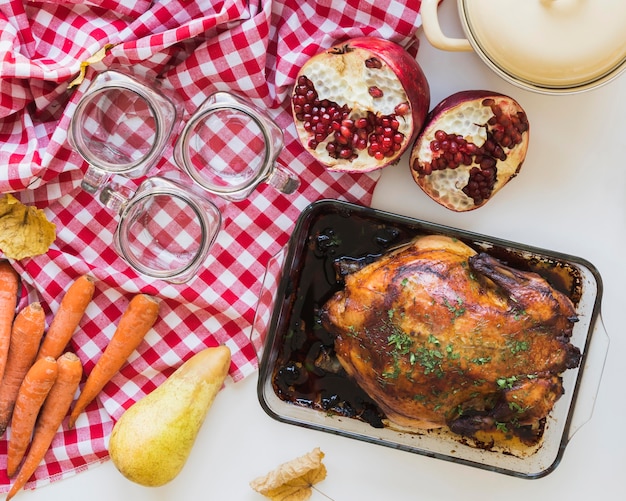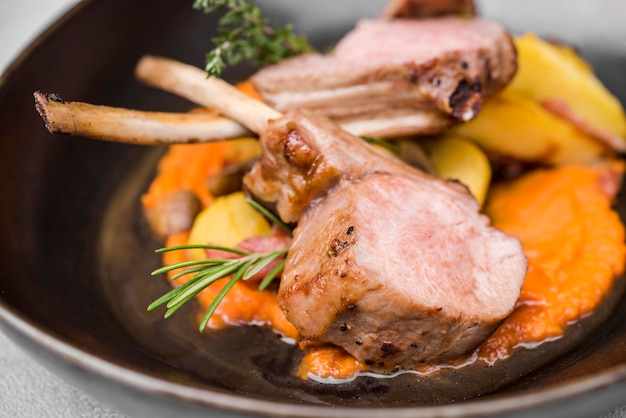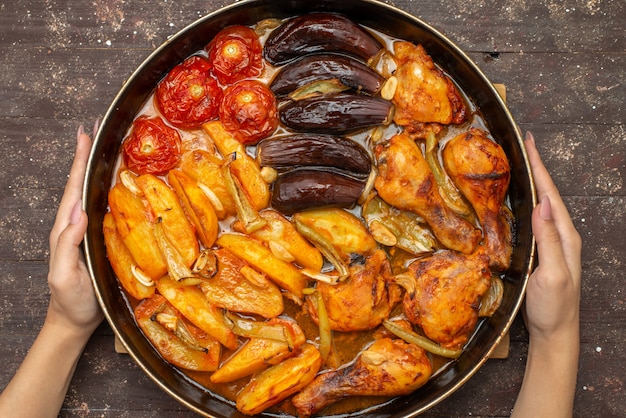Ah, pot roast. Just the name evokes images of comforting aromas wafting through the house, a table piled high with steaming goodness, and the satisfying feeling of a meal that’s slow-cooked to absolute perfection. But let’s be honest, sometimes that perfect pot roast feels elusive. You stare at a hunk of beef, a mixture of anticipation and dread swirling in your gut. Will it be tender and juicy, or tough and dry? The key lies in understanding the delicate dance between time, temperature, and technique.
Over the years, I've had my fair share of pot roast triumphs and a few mishaps along the way. But through it all, I’ve learned a thing or two about getting that perfect pot roast every time. Today, I want to take you on a journey into the heart of pot roast cooking, exploring all the nuances that contribute to a truly magnificent meal. We'll delve into choosing the right cut, mastering different cooking methods, understanding the importance of seasoning, and, of course, figuring out exactly how long to cook it for.
Part 1: The Roast: Choosing the Right Cut

The foundation of any good pot roast is the cut of meat itself. You want something that’s going to stand up to slow cooking, a cut that will break down and become incredibly tender as it simmers away. While several options exist, here are a few of my go-to choices:
chuck roast
This is the quintessential pot roast cut. It’s known for its rich flavor and that melt-in-your-mouth tenderness that comes from slow cooking. Chuck roast has a good amount of fat marbling, which is essential for keeping the meat juicy and flavorful. Think of those little streaks of fat like tiny flavor bombs, adding depth and richness to the whole dish.
Remember that time I tried chuck roast for the first time? I was a bit skeptical at first. It looked a bit tougher than other cuts. But once I slow-cooked it for hours, it transformed into a culinary masterpiece. Those little bits of fat melted away, leaving behind the most incredibly tender, flavorful meat. It was a revelation!
Brisket
Brisket, a cut often associated with barbecue, is another excellent choice for pot roast. It’s a tough cut, yes, but when slow-cooked properly, it becomes incredibly tender and flavorful. You get that beautiful, smoky flavor, which is always a bonus in my book.
Now, I’m not going to lie, brisket is a bit of a commitment. It’s a thick, substantial cut, and it needs a good long cooking time. But that long cooking time is also what makes it so special. It’s a true labor of love, and the reward is worth every minute spent in the kitchen.
Round Roast
Round roast is a leaner option compared to chuck roast, but it can still be a delicious choice. Just be mindful that it’s more prone to drying out, so look for a cut with some marbling or consider adding extra moisture during cooking. I often add a splash of broth or wine to my round roast, which helps to keep it tender and flavorful.
Beyond the Basics: Exploring Other Options
Don’t be afraid to explore other options beyond these classic cuts. Bottom round, rump roast, and even shoulder roast can all be transformed into delicious pot roasts with a little patience and the right techniques. Experiment, find what you like best, and remember, the world of pot roast is your oyster!
Part 2: Cooking Methods: A Guide to Your Options

Now that you've got your chosen cut of meat, it’s time to decide how you're going to cook it. Each cooking method has its own charm and brings a different flavor profile to the pot roast.
The slow cooker: The Hands-Off Hero
For effortless pot roast perfection, the slow cooker is my go-to. It’s a set-it-and-forget-it kind of cooking, perfect for busy days or those times when you want to come home to a warm, comforting meal. You simply toss the roast into the slow cooker with your favorite vegetables and some flavorful broth, set it on low, and let it work its magic for 6-8 hours. The slow, even heat breaks down the connective tissues, transforming the tough meat into a tender masterpiece.
The Oven: A More Hands-On Approach
Oven cooking offers a bit more control over the process. You can start by searing the roast, which adds a beautiful crust and intensifies the flavors. Then, it goes into a dutch oven or roasting pan, where it cooks slowly and evenly until it reaches the desired tenderness. It might take a bit longer than slow cooking, but the results are truly divine.
The instant pot: Speed and Efficiency in One
The Instant Pot is a culinary game-changer for busy cooks. You can sear the roast in the pot itself, then cook it under pressure for a surprisingly short time. It’s perfect for weeknights when you need a delicious meal on the table fast. But remember, while the pressure cooking time is shorter, it’s still crucial to let the roast rest after cooking for the juices to redistribute.
The Stovetop: A Classic Approach
Don’t underestimate the power of stovetop cooking. It’s a classic approach, perfect for those who enjoy the tactile experience of cooking, constantly adjusting the heat and tending to the pot. For this method, you’ll need a heavy-bottomed pot or Dutch oven to ensure even cooking.
Part 3: The Importance of Seasoning: Bringing Out the Flavour

Seasoning is the art of unlocking the hidden flavor potential of your pot roast. It’s not just about adding salt and pepper; it’s about creating a symphony of aromas and tastes that will tantalize your taste buds.
Essential Herbs and Spices: The Flavor Palette
Here are some classic herbs and spices that elevate a pot roast from good to amazing:
- Rosemary: A touch of rosemary adds a savory, earthy note, reminiscent of autumn evenings and crackling fireplaces.
- Thyme: A subtle, lemony flavor that complements the richness of the meat.
- Garlic: The king of flavor, garlic adds depth and complexity. I always use a generous amount of garlic in my pot roast, and it never fails to impress.
- Onion: A versatile ingredient, onion provides a base for savory and sweet notes, balancing the richness of the meat.
- Black Pepper: A touch of heat and complexity to wake up your taste buds.
- Paprika: Adds a touch of sweetness and a vibrant color, which always looks beautiful on the plate.
- Bay Leaf: A staple in pot roast recipes, the bay leaf contributes a subtle, earthy aroma that lingers long after the meal is over.
Salt: The Unsung Hero of Flavor
Don't underestimate the power of salt. It’s often overlooked, but it's essential for bringing out the natural flavors of the meat. It draws out moisture, tenderizes the meat, and improves its overall flavor. Don’t be afraid to season generously. A little salt goes a long way!
Part 4: Cooking Time: The Delicate Balance
Now, the question that’s always on everyone’s mind: how long do I cook this thing? There's no magic number; it all depends on several factors.
- The size and weight of the roast: A larger roast will obviously need more time to cook than a smaller one.
- The type of cut: Some cuts are naturally tougher than others and require longer cooking times to achieve tenderness.
- The cooking method: Each method has its own ideal temperature and time settings.
- The temperature of your oven or slow cooker: Different ovens and slow cookers have slightly different temperature variations, so it’s good to keep an eye on things.
Here are some general guidelines, but remember, these are just estimates. Always check the internal temperature of the meat to ensure it’s cooked through.
Cooking Method | Estimated Time
---------------------------------------------------------------------------------------| Slow Cooker | 6-8 hours on low, or 3-4 hours on high |---------------------------------------------------------------------------------------| Oven | 2-3 hours at 325°F (160°C) |---------------------------------------------------------------------------------------| Instant Pot | 60-90 minutes on high pressure |---------------------------------------------------------------------------------------| Stovetop | 2-3 hours over low heat |---------------------------------------------------------------------------------------Part 5: The meat thermometer: Your Cooking Companion
A meat thermometer is your trusty sidekick in the kitchen. It takes the guesswork out of cooking and ensures your roast is cooked to perfection.
The Ideal Temperature: Finding the Perfect Doneness
For a pot roast, you want to cook it to an internal temperature of 145°F (63°C) for medium-rare, 160°F (71°C) for medium, or 170°F (77°C) for well-done.
Using a Thermometer: Ensuring Accuracy
Insert the thermometer into the thickest part of the roast, making sure it's not touching any bone. Wait for the thermometer to register the temperature, and then remove it.
What to Do If It’s Not Done Yet: Patience is Key
If your roast isn’t quite done yet, don’t fret! Simply put it back in the oven or slow cooker and continue cooking until it reaches the desired temperature.
Part 6: The Resting Period: Crucial for Tenderness
Once your pot roast is cooked through, it’s not time to carve it just yet. Give it a 10-15 minute rest. This allows the juices to redistribute throughout the meat, resulting in a juicier, more tender roast.
Cover the roast loosely with foil during the resting period to prevent it from drying out. Use this time to whip up some delicious gravy, which is the perfect complement to a perfectly cooked pot roast.
Part 7: The Gravy: A Flavorful Finish
Gravy elevates any pot roast to a whole new level of deliciousness. It’s that rich, savory sauce that pulls the entire meal together.
Ingredients: A simple recipe
- 2 tablespoons butter
- 2 tablespoons all-purpose flour
- 2 cups pot roast juices
- Salt and pepper to taste
Instructions: A Quick and Easy Guide
- Melt the butter in a saucepan over medium heat.
- Whisk in the flour and cook for 1 minute, stirring constantly.
- Gradually whisk in the pot roast juices, cooking until the gravy thickens.
- Season with salt and pepper to taste.
Serve the gravy over your pot roast, and enjoy!
Part 8: Serving Your Pot Roast: A Feast for the Senses
Your pot roast is cooked to perfection, now it’s time to create a masterpiece on the plate. Here are some ideas to tantalize your taste buds and create a truly memorable meal.
Classic Serving Options: Timeless Delights
- Slice the pot roast and arrange it on a platter, with a generous helping of gravy, mashed potatoes, gravy, and your favorite vegetables.
- Create pot roast sandwiches with sliced roast and gravy on crusty rolls.
- Add sliced roast to a salad for a hearty and flavorful meal.
Embrace Your Creativity: Taking Pot Roast Beyond the Ordinary
Don’t be afraid to get creative and think outside the box! Use your pot roast as a base for other dishes like pot roast tacos, pot roast pizza, or pot roast quesadillas. Let your imagination run wild!
Part 9: Leftovers: A Culinary Treasure
One of the best things about pot roast is that it's a great meal-prepping option. Leftovers can be transformed into a variety of dishes, giving you delicious and budget-friendly meals for days to come.
Leftover Pot Roast Ideas: Transforming Yesterday’s Dinner into Today’s Delights
- Make pot roast hash for a hearty breakfast or brunch.
- Add leftover roast to a pasta dish for a flavorful twist.
- Make pot roast soup for a comforting and satisfying meal.
- Serve leftover roast on top of a bed of rice or quinoa for a quick and easy dinner.
Part 10: FAQs: Your Pot Roast Questions Answered
Here are some common questions about pot roast cooking that I often get asked.
1. What if my roast is too big for my slow cooker?
If your roast is too big for your slow cooker, you can either cook it in two batches or cook it in the oven. For oven cooking, follow the instructions in Part 2.
2. Can I cook a pot roast in the Instant Pot without searing it first?
Yes, you can cook a pot roast in the Instant Pot without searing it first. However, searing the roast will give it a beautiful crust and enhance the flavor.
3. Can I add more liquid to my pot roast while it's cooking?
It's generally not necessary to add more liquid to your pot roast while it's cooking. The liquid you add initially will be sufficient. If you notice the roast is getting too dry, you can add a little more broth or wine.
4. How do I know if my pot roast is done?
The best way to know if your pot roast is done is to use a meat thermometer. The internal temperature should reach 145°F (63°C) for medium-rare, 160°F (71°C) for medium, or 170°F (77°C) for well-done.
5. Can I freeze leftover pot roast?
Yes, you can freeze leftover pot roast. Store it in an airtight container or freezer bag for up to 3 months. Thaw it in the refrigerator overnight before reheating.
I hope this guide has helped you unlock the secrets to cooking a perfect pot roast. Remember, practice makes perfect. Don't be afraid to experiment and find what works best for you. Enjoy your pot roast adventures!
Everyone is watching

Corn on the Cob: The Ultimate Guide to Perfectly Cooked Ears
Healthy MealsAh, corn on the cob. Just the name evokes images of sunny days, barbecues, and that sweet, juicy flavour that ...

Scallops: The Ultimate Guide to Perfect Cooking
Healthy MealsAh, scallops. Those delicate, sweet, and utterly delicious morsels of the sea. They hold a special place in my...

Spaghetti Squash: The Ultimate Guide to Cooking and Serving
Healthy MealsRemember that time you saw spaghetti squash at the supermarket, looking all bumpy and strange, and thought, "W...

Salmon Cooking Times: Perfect Guide for Every Recipe
Healthy MealsLet me tell you, cooking salmon is an art form. It's all about getting that perfect balance: juicy and tender,...

Ham Cooking Time: How Long to Bake, Smoke, or Boil a Delicious Ham
Healthy MealsAh, ham. It's a classic, isn't it? A real crowd-pleaser, especially around holidays. And when done right, it'...
